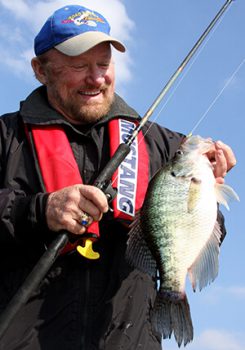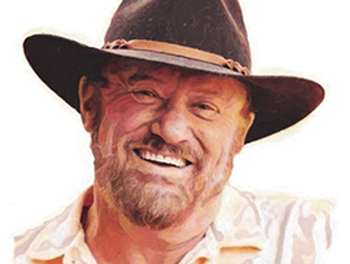
O’Neill with a fine catch.
It’s easier to handle first what you will not receive from our occasional visits before looking into what you may gain. Please do not expect the exotic wild game hunt descriptions from, for instance, Ernest Hemingway’s “Snows of Kilimanjaro” nor the excitement so elegantly described the running of the bulls in his “Death in the Afternoon” in Pamplona, Spain, or the giant gamefish so well-chosen symbolically in “The Old Man and the Sea.” Indeed not. Other than an occasional personally witnessed visit somewhere from Texas through Louisiana and across the Southeast to Florida, it’ll be local Georgia. Indeed yes, an afternoon on a Southern reservoir to round up a largemouth or a striper, a 2-acre bream or catfish pond to get something for dinner, a gentle mountain trout stream or a grey morning overlooking a Whitetail trail will be our focus. It allows me, with your permission, to post a recommendation or reminder or two for you to make more trips, go more often, be more productive and to suggest you round up youthful companions. Expecting and understanding that, let’s visit:
We’re deep into the Whitetail Deer season. How has it worked so far? Did you start properly preparing in August and September? I love generalizations. Here’s one: To be a better deer hunter, you must be a woodsman. What I mean is that you must understand what’s going on among the deer herd, how they interact, what to expect from that interaction and how you make the most of it. Where, in the forests, do deer spend their time and what is the “timing” of their day. In doing so, you’ve made it a hunt and not just a “shoot.” After all, for most hunters, the deer season, with you making observations, choices and finally picking targets may only involve you making a half dozen shots either with a bow, muzzleloader or centerfire rifle. Sounds dull. Unless you accomplish a high level of what I call “woodsmanship,” it is. Many Whitetail hunters do not hunt at all, instead making deer camp a social opportunity and that, to me, is just fine. So, what is the most important item in making you a woodsman? Time in the woods based on reliable knowledge and not fireside speculation. If you don’t spend the time, you can’t confirm what you’ve learned.
Did I mention that I love generalizations? Maybe I did. Anyway, the water right now, where the fish spend most of their time, is cold. What is the generalization? Cold water means that the gamefish: crappie, bass, stripers, bream, spotted bass, catfish, those slippery little critters that you’re trying to trick, or outsmart, have abandoned that shoreline with all those visible targets you love so much and are now deep. I mean deep. Bass and catfish at 40 feet. Stripers below that most of the time and bream and crappie at 35. A couple of years ago I spooned up a striper at Lanier at 97 feet. What is the striper’s limit? The bottom. That’s deep. Will you witness exceptions? Of course, 40 feet at Lanier, Carters and Blue Ridge is 20 at Oconee, Sinclair and West Point and 10 at Seminole.
OK, was that worthwhile? Hope so. Oh, by the way, if you think it might be interesting, you may find my book, “O’Neill Outside,” at my website, oneilloutside.com. Order it there and I’ll sign it to you personally. Secondly, if you’re up early on Saturdays, tune in to WSB AM 750 or 95.5 FM and join me for “O’Neill Outside” radio (4 a.m. to 6 a.m.). We’ll talk fishing and hunting.
Photo: provided by O’Neill Williams





